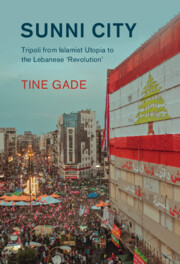Book contents
- Sunni City
- Cambridge Middle East Studies
- Sunni City
- Copyright page
- Contents
- Figures
- Acknowledgements
- Who Is Who in Tripoli?
- Timeline of Major Events
- Note on Arabic Transliteration
- Introduction
- 1 Tripoli’s City Corporatism and Identity Politics during the Nationalist Era (1920–1979)
- 2 Regional Proxy War
- 3 The Postwar Erosion of Tripoli’s City Corporatism
- 4 The Globalization of Islam and the Crisis of Religious Authority
- 5 The Future Movement
- 6 Tripoli’s Islamists
- 7 The Impact of the Syrian Civil War and Beyond (2011–2020)
- Conclusion
- Bibliography
- Index
- Books in the Series
Conclusion
What Can Tripoli Tell Us about Violence and Ideological-Political Activism in the Middle East?
Published online by Cambridge University Press: 10 November 2022
- Sunni City
- Cambridge Middle East Studies
- Sunni City
- Copyright page
- Contents
- Figures
- Acknowledgements
- Who Is Who in Tripoli?
- Timeline of Major Events
- Note on Arabic Transliteration
- Introduction
- 1 Tripoli’s City Corporatism and Identity Politics during the Nationalist Era (1920–1979)
- 2 Regional Proxy War
- 3 The Postwar Erosion of Tripoli’s City Corporatism
- 4 The Globalization of Islam and the Crisis of Religious Authority
- 5 The Future Movement
- 6 Tripoli’s Islamists
- 7 The Impact of the Syrian Civil War and Beyond (2011–2020)
- Conclusion
- Bibliography
- Index
- Books in the Series
Summary
This book has asked whether and why Sunni secondary cities in the Middle East have a higher propensity for unrest and ideological-political activism than capital cities. Taking Tripoli in northern Lebanon as a microcosm of the crisis of Sunnism in the broader Middle East, the book tells a story of urban violence in the 20th and early 21st centuries.
Throughout the Tripoli case study, this book identified a feature of secondary cities that I call city corporatism. The root of violence in secondary cities is that these cities often see themselves as united during national turmoil, as a base for one political faction, generally the opposition.
The book identifies four causal mechanisms that jointly explain why urban violence erupts in secondary cities: external meddling; the personal ambitions of local elites; local residents’ willingness to join the fighters; and the existence of competing, or hybrid, Lebanese sovereignties. Each mechanism helps explain why Tripoli has been prone to violence in recent decades.
Keywords
- Type
- Chapter
- Information
- Sunni CityTripoli from Islamist Utopia to the Lebanese ‘Revolution', pp. 228 - 240Publisher: Cambridge University PressPrint publication year: 2022

